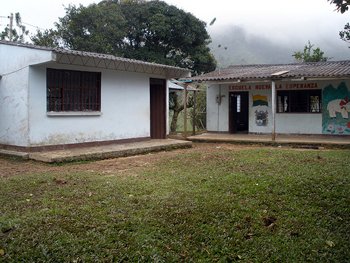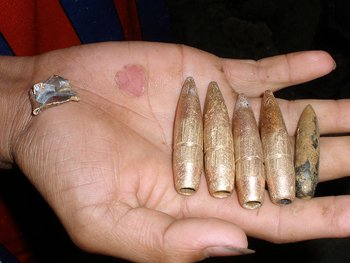


Two Steps Back for Human Rights in Colombia
“New” Colombian Army Unit Bombards, Pillages Elementary School in Catatumbo Region
By Andrew Willis Garcés
Special to The Narco News Bulletin
February 17, 2009
The Colombian Army’s brand-new 23rd Mobile Brigade, pursuing National Liberation Army (ELN) rebels, pounded a school and nearby home on Monday, February 2 with bombs, rockets and machine-gun fire in the hamlet of La Esperanza, in San Calixto municipality, Norte de Santander department. The area, part of the war-torn northeastern region known as Catatumbo, is sparsely populated, with less than ten homes within 500 meters of the school, spread out across a perpetually fog-covered mountain.
 Photos Andrew Willis Garcés D.R. 2009 |
Calls to the army’s 2nd Division commanders requesting comment on the operation and reports of property theft were not returned. The aerial attacks by the Arpia AH-60L gunship were reportedly carried out by Air Force Unit No. 5.
These acts were verified by one Spanish citizen and one US citizen, accompaniers with International Peace Observatory, and a representative of the San Calixto Personería, a state agency charged with protecting the human rights of Colombian citizens, all of whom visited La Esperanza February 8.
“Fresh Start” After Army Assasinations Scandal?
This wouldn’t be as newsworthy considering similar recent violence in Catatumbo if not for the auspicious origins of the week-old army unit that carried out the ground attack and occupation.
Last month the Minister of Defense Jose Manuel Santos announced a shakeup following the “false positives” scandal that broke in October, in which dozens, perhaps hundreds of army officers were implicated in a scheme to execute ordinary civilians and make their victims look like guerrilla combatants. According to a report by an NGO coalition, at least one civilian was killed in this way every day from January ‘07 to June ‘08. These murders have been an issue particularly in the Catatumbo region, where in December the campesino association ASCAMCAT held a public hearing for a senator, giving voice to the families of over 200 victims.
 |
Santos had claimed this was a “fresh start” for the 2nd Division. Soldiers were recruited for the brigade from other divisions, reportedly receiving human rights instruction. But the results of the attack were much the same as other recent, arbitrary operations affecting civilians in Catatumbo. On January 1, the Fifth Mobile Brigade carried out a similar bombardment in the community of La India in Tibú municipality, also affiliated with ASCAMCAT. An IPO accompaniment team verified that the army backed by the same air force unit hit the town with 500-pound bombs, and rockets fell within meters of homes. In that case, there was no sign of guerrilla presence, before or after the attack.
Terror Under Seige
The attacks last week left one young campesino injured, two dead cows and wounded a donkey. There are dozens of quarter- and fist-sized holes in roofs, windows and walls, and the area is filled with trash left by the soldiers. Student play areas and the soccer field are pockmarked with craters from rockets and other projectiles. A woman and her two young sons and two pregnant women were present at the time their house was hit by gunfire just south of the school, with a bomb or rocket detonating a mere ten meters away.
 |
One Step Forward, Two Steps Back
This incident illustrates the halfhearted nature of the Uribe government’s voluntary reforms. Criticized for months in the mainstream media and elsewhere, the government finally acted last month to replace sacked army officers and describe how they planned to prevent these acts from recurring. But the victory won by campesino leaders – official recognition of the widespread “false positive” killings – has not been matched with a change in treatment of campesinos by the army.
So far neither local nor national governments have made any sign of investigating the attacks in La Esperanza. A delegate sent by the General Prosecutor’s office in Ocaña to confirm the attacks reported by ASCAMCAT advised local residents to flee with what belongings they could carry, and told one of the group’s leaders that the school only needed “a little paint.”
 |
It’s unknown if either of the units responsible for the attack receive Plan Colombia funding; several calls to the US Embassy’s State Department Verification Office went unreturned. But the US has in recent years continued to fund army units in areas where the army is responsible for rights violations. A report released last year by Amnesty International and the Fellowship of Reconciliation shows that geographic regions with the highest levels of reported extrajudicial executions of civilians by members of the armed forces in 2006 were also largely regions with the most military units receiving US assistance.
Video of a tour of the elementary school La Nueva Esperanza (“The New Hope”) after the army attack:
http://www.youtube.com/watch?v=txinWSxsjUQ
Interview with a resident whose house was hit in the attack:
http://www.youtube.com/watch?v=i5qL_nFZ4sM&feature=related
Andrew Willis Garcés is an organizer from Washington, DC who works with the International Peace Observatory in Colombia. Read his blog at http://todossomosgeckos.wordpress.com
- The Fund for Authentic Journalism
For more Narco News, click here.




